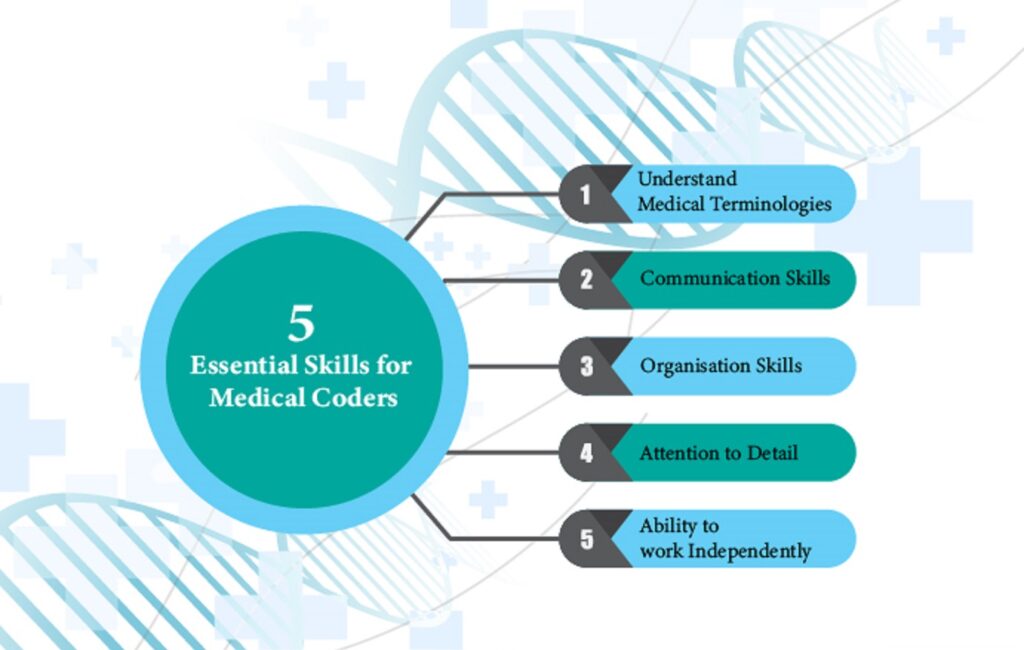Your 5-Step Guide to Become a Medical Coder

You’re interested in capitalizing on the exciting growth in the healthcare industry, but you’re not interested in providing direct patient care. You certainly have options outside of a clinical setting, but the behind-the-scenes nature of the position and the daily duties of a medical coder make it seem like the perfect entry point for you.
These healthcare professionals play an important role in the medical ecosystem as they help process and organize the massive amounts of patient and billing data produced every day. This complex process helps keep funding flowing, improves patient experiences and can even contribute to healthcare research.
While that sounds like a solid line of work, you need to gain a better understanding of the road ahead before committing to this career path. To help with that, we’ve compiled a variety of important information to break down the process and provide you with a guide on how to become a medical coder.
How to become a medical coder: 5 straightforward steps
Before we break down the steps, let’s explore why this role matters. Whenever you have a doctor’s appointment, the healthcare provider records notes about which procedures took place and what was diagnosed. Using their knowledge of thousands of medical codes, payment policies and government regulations, medical coders take medical records and code them in a standardized system for billing and insurance purposes.
Without them, the providers wouldn’t know what to charge for each procedure, and insurance companies wouldn’t be able to cover patient care properly. Now that you know a little more about the position, read ahead to learn how you can become one.

Step 1. Meet the basic prerequisites
First things first: To become a medical coder, you will need a high school diploma or equivalent. You also will need to pass a background check. Applicants with a criminal history involving drug offenses or sexual crimes will most likely be turned away.
Step 2: Complete medical coding training
Next, you’ll need to start training and learning the ins and outs of these coding systems and how the medical billing process works. While there are no formal education requirements to become a medical coder, this is a step that can make you a more appealing candidate for employment. Many employers are seeking candidates with a postsecondary certificate, with some requiring an associate’s degree, according to the (BLS).
Pursuing formal education is a smart step for those who want to enter the field with a solid foundation of knowledge. Even better, these programs are comparatively short to other education options—in fact, the Medical Billing and Coding Certificate program at Rasmussen University can be completed in as few as nine months.2 Here’s a taste of some of the courses students take:
Medical coding courses:
- Coding Foundations
- ICD-CM Coding
- ICD-PCS Coding
- Ambulatory Coding
- Health Information Law and Ethics
- Health Information Pathophysiology and Pharmacology
Gaining practical training and a solid understanding of the field will allow you to hit the ground running as soon as you land your first medical coding job. You can even complete your medical coding training online, making this step an achievable option even if you’re already working elsewhere.
Step 3: Obtain medical coding certification
Graduating from a medical coding certificate program is an impressive accomplishment. But your work isn’t quite over yet if you’re looking to become a well-rounded candidate for medical coding jobs. The next step is getting certified.
While earning a certification isn’t a legal requirement for employment, many employers may prefer candidates who have earned medical coding certification, according to the BLS. And understandably so—earning professional certification shows employers you’re dedicated to the role and have demonstrated many of the important skills required to succeed on the job. The choice to specialize is ultimately yours, but it’s a choice worth careful consideration.
There are a few certifications for medical coders to choose from.
Common medical coding certificates:
- Certified Professional Coder(CPC®)
- Certified Coding Associate(CCA®)
- Certified Coding Specialist(CCS®)
- Registered Health Information Technician (RHIT®)
Once you gain some experience in the field, you may decide you’d like to specialize your coding career. If so, you might consider pursuing specialty medical coding certification in an area such as ambulatory care, anesthesia, family practice, general surgery or many others.
Step 4: Brush up on in-demand medical coding skills
Before you start applying for medical coding jobs, it’s helpful to know exactly what employers are looking for so you can be prepared and put your best foot forward with a well-tailored resume. Being an effective medical coder requires a balance of hard and soft skills.
We used real-time job analysis software to examine over 184,000 job postings for medical records specialists and health information technicians over the past year.3 This data helped us identify the top skills employers are seeking in medical coding job candidates. Here’s what we found.
Commonly sought-after skills and knowledge for medical coders:3
- Medical coding
- Medical billing
- Customer service
- ICD-10
- Medical records
- Health Insurance Portability and Accountability Act (HIPAA)
- CPT® coding
- Medical terminology/anatomy
- Scheduling
- Microsoft® Office
This list may seem intimidating at first glance but rest assured that these are precisely the types of skills taught in a medical coding certificate program. In addition to this technical training, there are some soft skills that help medical coders succeed.
Top transferable skills for medical coders:3
- Communication
- Collaboration
- Research
- Attention to detail
- Organization
- Problem solving
If you can identify with some of the traits above, you may be a natural fit for the field. Your medical coding training will help you round out your skills so you’re prepped for success.
Step 5: Find a job
The next step to becoming a medical coder is to land your first job. The good news is that occupations that use medical coding skills appear positioned for continued growth. The BLS projects employment of medical records specialists to increase seven percent from 2021 through 2031.1 Employment of health information technologists and medical registrars, a closely related field, is projected to grow by 17 percent during that same time frame.1
There are a number of settings for medical coding professionals, so adjust your search as needed. Once you get your foot in the door and start gaining experience, you can begin considering future advancement opportunities. There’s an entire cluster of health information careers you can potentially grow into from here, so keep an eye to the future as well.

Take the first step toward becoming a medical coder
Now that you’re more familiar with the path to becoming a medical coder, why wait? There’s no better time than now to join the ranks of the growing medical field and feel the ultimate satisfaction of a career that allows you to help others.
Learn more about the career and the training ahead by visiting the Rasmussen University Medical Billing and Coding program page.